Grow your e-commerce sales using RFM analysis - an undervalued online retail marketing technique
We can all agree that conversion rate optimization is one of the most creative and efficient marketing techniques for designing an on-site experience that will amaze customers. Yet even though CRO will help you rectify your approach as you work to align marketing goals with customer’s needs, there is one important aspect to consider: conversion rate optimization is often used in the wrong way.
As a marketer or e-commerce website owner, your main goal shouldn’t be only to improve key metrics such as conversion rate, bounce rate, average order value, revenue, etc. These represent a direct consequence, the effects of how you treat your customers and how you communicate with them.
You should also optimize to create long-term relationships with customers that have chosen your products and services from the crowded e-commerce market. The customer experience must be the core of any optimization process. Focusing on developing meaningful relationships instead of marking money the main goal, will increase visibility and strengthen your e-commerce business.
Traditional commerce vs. digital commerce
Most people consider e-commerce as a whole new approach with new selling techniques and new methods to make customers buy more and more. Well, this is not entirely true. The internet is just another protocol of communication and, while there are some undeniable differences between traditional commerce and digital commerce, the principle is the same.
Nowadays, the digital era has transformed communication into a cold process and buying from an e-commerce website that has no personalized communication at all might make users feel like robots. The sense of excitement is gone, and the lack of emotion will make them leave the website, go to competitors or simply go to a brick and mortar shop to enjoy the shopping experience.
Emotions trigger action and make us act in a certain way. Emotions keep us alive. Let’s go back in time and analyze some aspects of the traditional commerce that should be mandatory today for every e-commerce business. I’ll explain this using an example.
Back in the day, people used to go daily to the bakery and get fresh bread for their families. The most successful bread shops would learn people’s customs, what kind of bread they buy and would prepare the products before. Bakers used to connect with customers at a deeper level than a simple transaction.
Going to the bakery was more than buying bread, it was a friendly encounter that would satisfy people’s need of communication, of sharing small events and news that appeal to them. Thus, companies that sold bread would create a story for every loyal customer that returned to their store. Having this tight bond made clients return again and again to the same place to enjoy their daily routine.
It’s the same thing in the online industry. Creating emotions you create stories, and people will realize you’re more than a cold website selling products: you care for their needs, preferences, and you appreciate their loyalty.
Let higher conversion rate, low bounce rate, increased average order value be only the effect of the way you treat customers and of how you stimulate them to have a certain behavior.
Customer journey analysis in conversion rate optimization
The customer journey analysis is crucial in the conversion rate optimization process because it gives a full picture of the entire conversion path. It’s a deeper analysis of how visitors behave on site and it takes your CRO actions to the next level.
Understanding each phase of the customer journey will lead your business to a constant growth. Here are the customer journey phases:
- Awareness
- Desire
- Choice reduction
- Buying
- Returning to buy
- Promoting
While improving each funnel phase remember that customers have little credit to allocate to your business. The human attention span has decreased from 13 seconds (in 2000) to 8 seconds (in 2013). Visitors don’t read a page, they scan it and you have 8 seconds to grab their attention. It’s easier to impress a goldfish rather than a human since its attention span is 9 seconds.
Each customer phase is correlated with a certain customer need. For every phase, you should apply a specific marketing action and take things step by step.
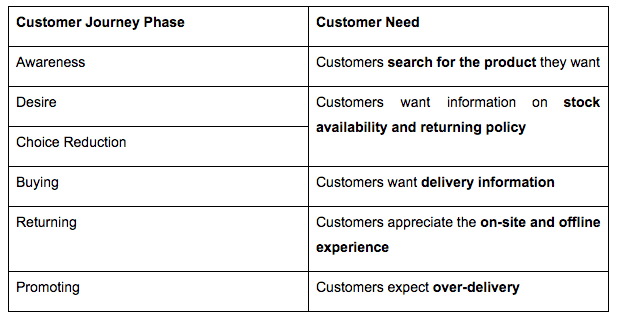
In the awareness phase, customers just got on your website and they are currently looking for the product they need. So, you have to simplify the search process and make things easier. In this pre-purchase stage, there are three possible conversion paths that users can take:
- directly search for a certain product
- go through categories until they find a product that fits their needs
- use filters to find products according to specific criteria: size, price, brand
Think about it for a second: if users search for something it means they have the intention to buy. Here are some statistics to make you see the importance of site search in e-commerce:
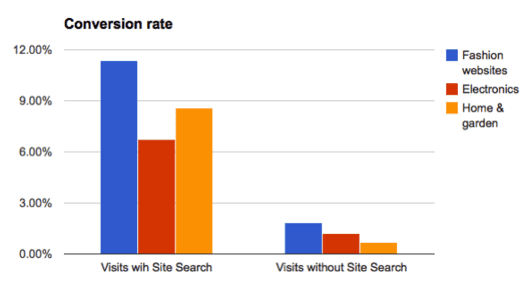
After the awareness phase, visitors go to the desire and choice reduction phase. In these two steps, you need to assure customers you have what they want: display stock availability information. Also, let them know about the returning policy and remove their fears about costs on returning the products if there’s something wrong with them.
The main goal now is to persuade customers to add the product to the shopping cart. But, if there are too many options, too many links, then it’s more likely to lose that customer: they’ll see something else, click on it and go to the other page.
Sometimes, less is more. Consumers exposed to limited choices will decide faster to proceed to the next step. Here’s how:
The customer journey is longer when users have to click more than 5 times and it’s likely to lose them on the way:
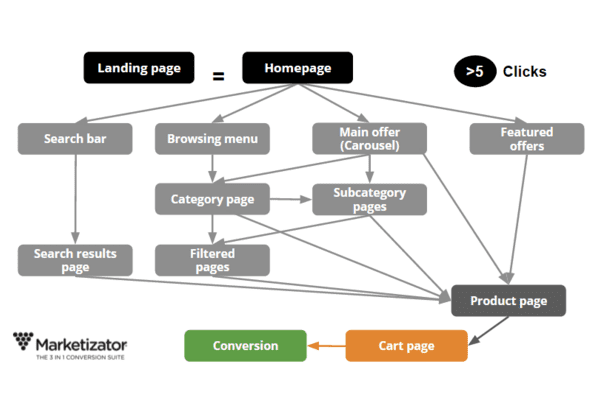
When the customer journey begins on the category page, it takes more than 4 clicks to convert:
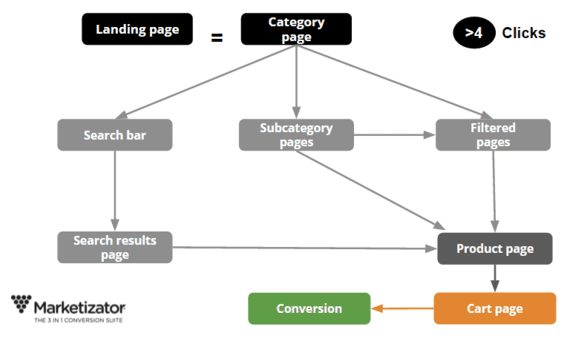
But, here’s what happens when you send visitors directly to the product page: only two clicks to convert.
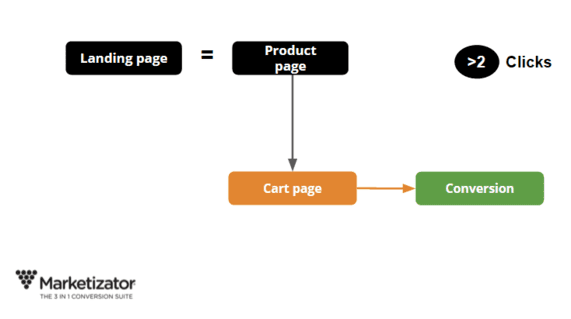 In the next phase, users are on the cart page, ready to buy. There are two main aspects that might distract them from placing an order: the security of the payment method and the delivery option. If you manage to break down these purchasing barriers, you’re set.
In the next phase, users are on the cart page, ready to buy. There are two main aspects that might distract them from placing an order: the security of the payment method and the delivery option. If you manage to break down these purchasing barriers, you’re set.
Now you have a conversion: a user went to the first funnel stages and placed an order. It’s time to make him return and buy again from your e-commerce website. But how will he decide whether to return to you or go to a competitor’s website? Well, he’ll return to you if he had a good experience the first time. If everything went smoothly and he was satisfied with the on-site and offline experience, it’s likely he’ll remember you for further purchases.
The key to success in the e-commerce industry is to transform clients into promoters of your brand and become a top of mind choice for loyal customers. In this stage, you can impress customers by over delivering. Surprise your most loyal customers and focus on building a strong relationship with them.
Let emphasize the main conclusions we’ve discussed so far:
- Focus on creating authentic relationships with your customers
- Constantly increase your chain value and differentiate on the eCommerce market by over delivering
Retention vs. acquisition
I’ve recently discovered some statistics that prove how important is to create a loyalty system and why you should focus on engaging with your promoters by giving them a special treatment.
According to RJ Metrics, after 24 months, 50% of the revenue comes from returning visitors:
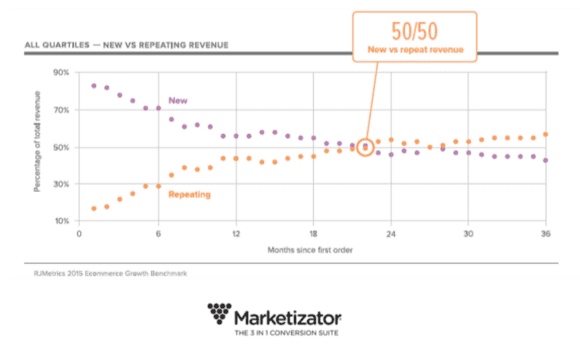
So, returning customers have a great growing potential for your eCommerce business. Not convinced yet? Check out what happens after 36 months: more than 50% of revenue comes from loyal customers:
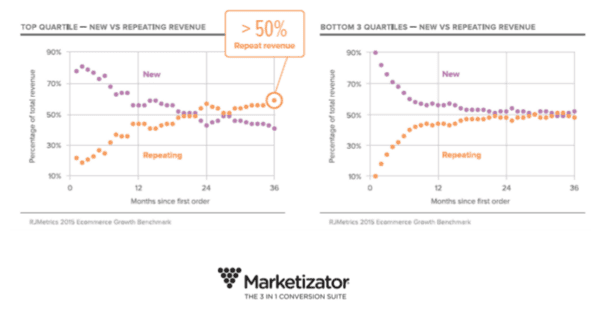
The question that comes now is: how to identify the loyal customers and how to segment your database? And, once you do that, how can you use the data to build a successful business model?
Next, I’ll show you how to improve your business performance based on the RFM Model.
How to build your RFM Model
The RFM pattern is a great marketing technique that will help you identify the most valuable customers, that bring the highest conversion rate. RFM is an acronym for:
- Recency - How recently did the customer buy?
- Frequency - How often do customers purchase?
- Monetary analysis - How much money do customers spend?
With this model you’ll filter your database considering most recent purchase date (recency), number of orders (frequency), total revenue generated (monetary analysis). Using this three modules, you’ll identify customers who have recently bought from you, customers who buy more often from your website and customers who spend more money.
Here is a free RFM Model Template that you can use.
After you add your data in the spreadsheet, this is how the database analysis results look like:
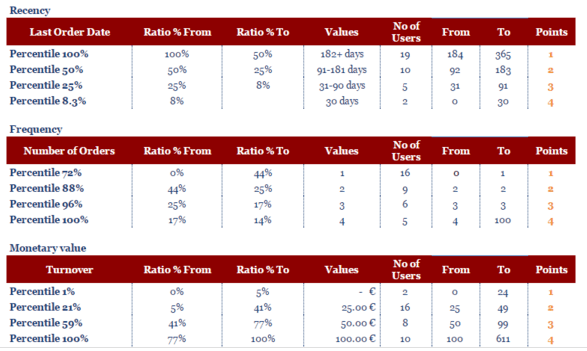
- Clients with high recency are more willing to buy rather than those who haven’t bought anything in a while;
- Clients that frequently buy are more willing to buy again rather than those who only bought once;
- Clients that usually spend lots of money are more willing to buy again and generate revenues;
You have the RFM Model - Now what?
- identify the customers with the highest RFM score
- start persuading then and give them a VIP treatment
- have your sales team call and give them special offers
- target them on social media campaigns: be visible to your VIP audience with promotions and over deliver
- Get promoters and over deliver
We all know that WOM (word of mouth) is a great advertising channel. We’d rather trust our friends than a salesman or an advertiser. You know for sure that the brand your best friend told you about is trustworthy. Build as many promoters as you can and you’ll see long term results.
Make a list of customers that have a Klout score > 60 and a RFM score between 10-12. Reach our the tipping point and watch the positive effects on your business.
Depending on your business phase, you will identify different traffic converting cohorts. For example, if you have a recency score 4, a frequency score 1 and a high monetary value it means that first time buyers generate most revenues.
- Use GTM to have a complete real-time personalization machine
Now, you have the most important customers and it is time to start communicating them what they want to hear.
Build conversational scenarios in your CRO testing package and address each segment according to the funnel phase.
To sum it up: What can you do with the RFM Model and GTM?
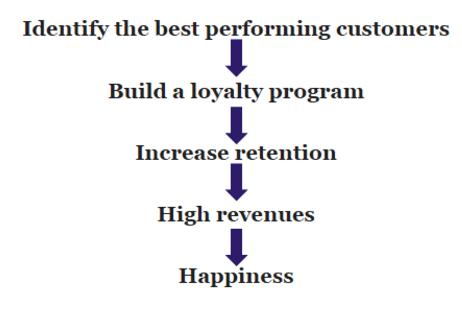

Thanks to
Valentin Radu for sharing their advice and opinions in this post.
Omniconvert Founder, Valentin Radu, has more than 5 years experience in consulting e-commerce companies to grow their conversion rate and revenue. With an entrepreneurial and marketing technology background, Valentin is always able to provide effective ideas for people who want to convert their organization into a growth machine.












 Thanks to
Thanks to 



